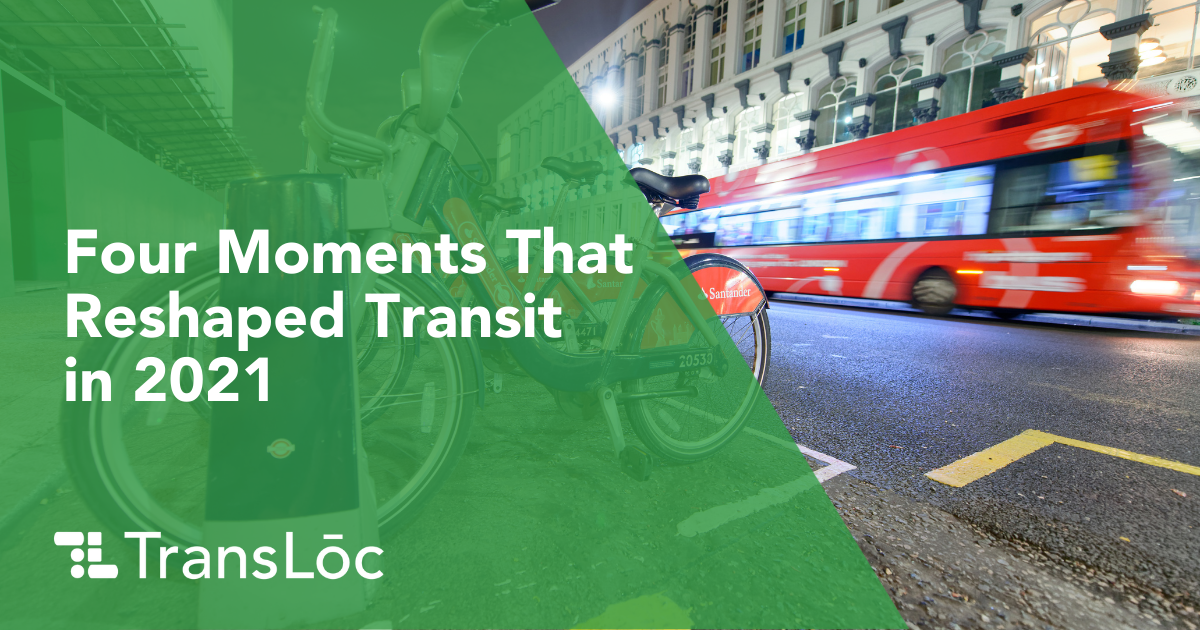
2021 gave us plenty to talk about in transit.
Historic infrastructure investments, the acceleration of vehicle electrification, riders showing confidence to use public transit once again — so many exciting stories that showcase the transit innovation currently sweeping across our industry.
As 2021 fades to black, we pinged some of the top transit minds at TransLoc for their thoughts on the moments of the year that could end up reshaping mobility as we know it.
Transit Showcased Its Resilience to the World
Ashley Schultz, Manager of Project Implementations: 2021 was a year of adaptability for all industries, including transit. Transportation providers continued to grapple with the pandemic, swinging between feelings of relief that the pandemic was nearing its end and distress that another variant would take us back to square one. Much like the rest of the world, transit agencies found ways to be resilient. They restructured services to increase efficiency and better serve riders’ changing needs, incentivized transit use to make riders feel more comfortable again (e.g., going fare free), and reconsidered how they hire and retain drivers.
Recommended Reading: Planning for Uncertainty with Flexible Transit
Vehicle Sanitation and Shorter Commutes Remained Top Priorities for Transit Riders
Tyler Means, Senior Business Strategist: The pandemic continued to play a big role in accelerating the future of transit. Ridership has recovered to about 66% of its pre-pandemic high. This pushed agencies to want to explore more operational characteristics or tech features that allow riders to better assess their safety including monitoring vehicle capacity and implementing low/no-touch fare payment. The commute also got a makeover with many private businesses turning white collar jobs into hybrid or full remote positions. This has reduced the number of peak hour commuters and changed the way people move around their community. It’ll be interesting to see the long-term effect of this change as it relates to how cities are shaped and how people move.
Recommended Reading: TransLoc’s 2021 Transit Value Index
Transit Riders Felt the Effects of the National Driver Shortage
Austin Stanion, Manager of Solutions Engineering: Driver shortages have been a long-simmering concern in the transit world, and the pandemic has brought it to a rapid boil. Wage competitiveness and negative health consequences has made it difficult to attract new licensed and qualified operators. Many drivers were temporarily furloughed at the start of the pandemic, and other positions at companies like Amazon, UPS, and FedEx offer more opportunity for public transit operators to grow their careers and put a sizable amount more money in their pockets. As transit providers try to solve the driver shortage issue while still delivering transit services to their communities, we could see an increase in on-demand microtransit services since operating those vehicles does not require a commercial driver’s license.
Mobility as a Service Arrived in the U.S.
Josh Cohen, National Director of Policy: After endless blog posts and conference sessions about Mobility as a Service (MaaS), the city of Pittsburgh finally released North America’s first MaaS project, Move PGH. The project integrates public transit with shared bikes, scooters, mopeds, and cars as a way to make it easier for the 20% of Pittsburgh households who don’t own a car to access jobs, education, healthcare, and community. Though not all the integrations are complete yet, this model is one that many communities will be watching to see what happens.
Recommended Listening: The Movement Podcast: On The Hunt for Mobility-as-a-Service
TransLoc is eager to support our transit partners in this new era of mobility. Let’s work together to identify how flexible mobility technology, smart data, and years of transit expertise can change the way your community moves.